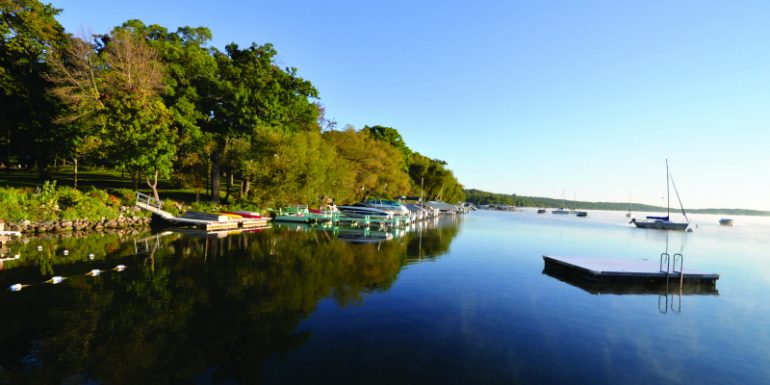By Sarah T. Lahey
The history of Lake Geneva holds a fascination for many people—residents and tourists alike—but we typically begin this story too late. Most accounts start with the Great Chicago Fire of 1871, or the arrival of the Northwestern Railway that same year. These monumental events permanently changed the Geneva Lakes area, bringing an affluent, Chicago-based population to the area. But what was happening before the era of Wrigley mansions and lavish parties on double-decker steamboats?
Farmers and frontiersmen arrived at Geneva Lake as early as 1833, and there is an interesting story to tell about their first years on the lake. But this article will focus on the Potawatomi Indians who protected these shores for nearly two centuries before white settlers came. Their legacy is too often forgotten, yet is crucial to understanding the real history of Lake Geneva.
POTAWATOMI BEGINNINGS
The earliest record of the Potawatomi, known as the “Keepers of the Council Fires,” places them in central New York in the early 1500s, along with other tribes of Algonquin stock. The violent uprisings of the Iroquois Confederacy forced them to move west, and the Potawatomi eventually relocated to central Michigan.
Even in Michigan, they were not safe. Renewed Iroquois attacks prompted yet another migration westward in the early 1600s. Fleeing for their life, the Potawatomi split into two major bands. One group traveled into northern Michigan, crossed through the Upper Peninsula, and settled in the Green Bay region. Another group moved along the southern shore of Lake Michigan, traveling through Indiana and then Illinois. These two groups eventually overlapped in Wisconsin.
Before I paint too soft a picture of the Potawatomi, let me say they incited their fair share of violence. When the Potawatomi moved into Wisconsin and Illinois, they waged what historians have called a “war of extermination” against existing tribes. Along with their allies, the Potawatomi killed off huge portions of the Illinois, Miami, and Peoria.
By 1700, the Potawatomi were 3,000 strong. Their tribal domain ran all the way from Door County, Wisconsin, to South Bend, Indiana. This began an era of dominance, in which the Potawatomi controlled half the Great Lakes fur trade and huge sections of the Midwest. The group at Lake Geneva was small, starting their first village in 1695, but they were part of this bigger picture.
THE LOST YEARS (1695-1800)
What came next for the Geneva Lake area is more difficult to determine. We know the Potawatomi as a whole allied with the French, fought in the Seven Years War, and helped to organize Pontiac’s Rebellion against the British. However, we really have no idea what Lake Geneva’s tribe was doing for most of the 18th century.
Paul B. Jenkins—an early historian of the area—explains this gap with one simple fact: trade routes did not run through Lake Geneva. All the major routes followed the Fox River or Lake Michigan, leaving this particular corner of southeastern Wisconsin very isolated. No traders or missionaries came through, meaning we don’t have their diaries and letters to provide written accounts of these times.
Jenkins described Lake Geneva circa 1830 as “an almost unknown earthly paradise of richness and beauty.” He felt it was a hidden gem: a place where the Potawatomi existed in peace and isolation. It is wrong, however, to think the Potawatomi lived in a bubble.
Lake Geneva’s Potawatomi traded at Fort Winnebago, east of today’s Portage, Wisconsin and at Fort Dearborn, built alongside the Chicago River in what is known today as Chicago’s loop, throughout the 1700s, exchanging animal skins for clothing and ammunition. There is further evidence of Indian trails weaving through Lake Geneva. The local Potawatomi went to places like Beloit, Kenosha, and Milwaukee, to name only a few. Even if missionaries and explorers did not travel into Lake Geneva, the Potawatomi did venture out.
BIG FOOT’S ERA (1800-1836)
Somewhere near the start of the 19th century, Chief Big Foot (known as MaunSauk) became leader of the Lake Geneva Potawatomi. He led his people, unfortunately, during a time of distress. White settlers moved to the area in increasing numbers, and diseases such as smallpox ravaged his villages. Nevertheless, there was a thriving community under Big Foot’s direction.
Big Foot led roughly 500 Potawatomi at “Lake Kishwauketoe,” or lake-of-clearwaters. It was only later named “Lake Geneva” by a U.S. government surveyor. Big Foot’s main village was located in what is now Buena Vista Park, a private subdivision in Fontana. It ran as far south as Gordy’s Marine and as far west as North Lake Shore Drive.
There was a smaller village site at Williams Bay. Here, the Potawatomi grew corn and had several workshops to make hunting tools. There was little activity on the eastern end of the lake, where the city of Lake Geneva now stands. The Potawatomi called it the “fishing place,” and used the area for hunting.
Evidence suggests the Potawatomi led a fluid lifestyle—living in the village one day and going out camping the next. Charles E. Brown, a prominent Wisconsin archeologist, found evidence of temporary campsites at: Aurora University, Cedar Point, Lake Geneva Manor, Elgin Camp, Belvidere Park, Country Club Estates, Big Foot Country Club, Glenwood Springs, Indian Hills, Fairoaks Camp, Rainbow Bay, the Chicago Club, Black Point, Twin Brooks, Buttons Bay, and several locations on Lake Como.
Connecting every aspect of Potawatomi life was the “lake path,” a 21-mile footpath that encircles the lake and exists to this day. It remains one of the only lake paths in Wisconsin to allow sightseers to cross private property.
SACRED SITES
The Potawatomi viewed several locations around the lake as sacred. One is an important Indian burial ground near today’s Pier 290 restaurant in Williams Bay. It featured the grave of two wives of Chief Big Foot. These remains were discovered by accident in the summer of 1920 by construction workers. They found the skeletons along with valuable beads, pottery, and other adornments marking the women’s status in the tribe.
Another sacred site is the waterfront at Buena Vista Park. When Big Foot’s son died tragically at the age of fourteen, the chief selected what’s known as a tree burial to honor him. The body was
wrapped up in a cocoon shape and placed in a burr-oak tree very close to the shore. Big Foot reportedly said, “He was always so fond of looking at the Lake that now his spirit shall be able always to look at its waters.”
Over the years, there has been much debate about the location of this tree. As of 2016, rumors still circulate. Writing in 1922, however, Paul Jenkins is adamant that speculation should stop. According to his research (which was exhaustive), the tree was destroyed in the winter of 1865 by Mr. C. B. Hollister, who desperately needed firewood. The grave had been disturbed many years earlier by looters.
The Potawatomi’s most hallowed ground was located in today’s Big Foot Country Club. It houses the Seven Sacred Pools, a group of stream-fed ponds believed to be inhabited by the gods. The Potawatomi consulted the spirits at this site in all tribal matters, including decisions of war. Members of the Potawatomi Nation returned to Big Foot Country Club several times throughout the 20th century to honor this sacred place.
A TYPICAL DAY
When they were not occupied with tribal matters, Potawatomi men spent most of their days hunting and fishing. Since navigating the water at Geneva Lake was paramount to survival, each Potawatomi boy—as a rite of passage—had to build his own canoe. The braves of Big Foot’s village carved their canoes out of linden and basswood trees because these were closest to the water.
The same young men held competitive races at Fontana Beach. Early settlers remembered the excitement of the races and the active betting pools surrounding them. Some of Big Foot’s men owned horses, so horse racing soon became another favorite pastime.
Potawatomi women spent most of their day farming, preparing food, and caring for children. When white settlers arrived, many thought it was odd that Indian women engaged in tasks such as plowing fields. Farming was considered a man’s job. It turns out, of course, that Potawatomi women held considerably more power than European women.
The Potawatomi were a matrilineal people, meaning they traced their ancestry on the mother’s side. They also made living arrangements accordingly. When a Potawatomi man got married, he moved to the home of his young bride— even if it meant joining a new tribe. He became part of his wife’s family, and worked on their behalf.
At the end of the day, Potawatomi men and women enjoyed each other’s company. Nighttime habits included drumming, dancing, singing, and chanting. Sometimes they held religious ceremonies to ward off evil water spirits (believed to inhabit Geneva Lake). But, other times, they simply gathered for fun.
THE KINZIE VISIT
Important changes came to Big Foot’s village in the form of Juliette and John H. Kinzie, who visited Fontana in 1831. They were on a U.S. military expedition, traveling from Fort Dearborn to Fort Winnebago, when they stumbled upon Geneva Lake. It was the first-ever recorded visit of white settlers to the area.
The Kinzie party approached Fontana from the south, first viewing the lake from what is now Glenwood Springs. Juliette Kinzie describes their reaction:
“Soon after midday, we descended a long, sloping knoll, and by a sudden turn came full in view of the beautiful sheet of water denominated Gros-pied by the French, Maun-suck by the natives, and Big Foot by ourselves, from the chief whose village overlooked its waters. Bold, swelling hills jutted forward in the clear expanse, or retreated slightly to afford a green level nook, as a resting place for the foot of a man. On the nearer shore stretched a bright gravelly beach through which coursed here and there a pure sparkling rivulet to join the larger sheet of water. On the rising ground, at the foot of one of the bluffs in the middle distance, a collection of neat wigwams formed…a shout of delight burst involuntarily from the whole party, as this charming landscape met our view.”
Taking a calculated risk, the Kinzie party approached Big Foot’s village with weapons holstered. Mrs. Kinzie claimed the Indians, “all assembled in front of their wigwams,” looked friendly but on guard. Fortunately, John H. Kinzie spoke the Potawatomi language, so everyone relaxed. He explained the reason for their travel, and young tribesmen brought fresh trout to eat.
Mrs. Kinzie published her reminiscences in Wau-bun: The Early Day in the Northwest (1856). The book was a huge success and brought many interested parties to the area. Her description and hand-drawn sketch of Big Foot’s village remain some of the only pieces of evidence we have of Potawatomi life at Geneva Lake.
POTAWATOMI REMOVAL
Friendly visits such as those of John and Juliette Kinzie, unfortunately, were harbingers of bad things to come. As the U.S. increased its military presence in the Midwest, it also negotiated more contracts to appropriate Indian land. From the Greenville Treaty of 1795 to the Chicago Treaty of 1833, the Potawatomi watched as their land was taken through a series of unfair negotiations and military strikes.
Chief Big Foot and his people viewed Geneva Lake and its surrounding area as precious land. They treated it with great respect and vacated in 1836 only after a hard fight. For the full story on how and why Big Foot’s tribe left, see our upcoming article in the autumn issue of At The Lake.





